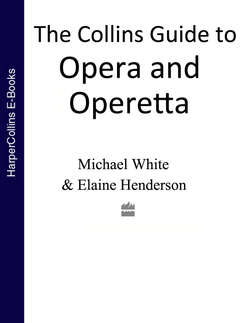Читать книгу The Collins Guide To Opera And Operetta - Michael White - Страница 43
ОглавлениеA Midsummer Night’s Dream
FORM: Opera in three acts; in English
COMPOSER: Benjamin Britten (1913–76)
LIBRETTO: Benjamin Britten and Peter Pears, after Shakespeare’s play
FIRST PERFORMANCE: Aldeburgh, 11 June 1960
Principal Characters
Oberon, King of the Fairies Countertenor
Titania, Queen of the Fairies Coloratura soprano
Puck Spoken role
Hermia, in love with Lysander Mezzo-soprano
Helena, in love with Demetrius Soprano
Demetrius, in love with Hermia Baritone
Lysander, in love with Hermia Tenor
Theseus, Duke of Athens Bass
Hippolyta, betrothed to Theseus Contralto
Bottom, a weaver Bass-baritone
Peter Quince, a carpenter Bass
Flute, a bellows mender Tenor
Snug, a joiner Bass
Snout, a tinker Tenor
Starveling, a tailor Baritone
Synopsis of the Plot
Setting: A wood near Athens and Theseus’ palace
ACT I Oberon and Titania have quarrelled over the possession of an Indian boy stolen by the fairies. Oberon plots revenge and instructs Puck to fetch the magic herb which, squeezed into the eyes, will make the recipient fall instantly in love with the next person they see. Oberon also plans to use the magic herb to help Helena, in love with Demetrius, who has eyes only for Hermia. Puck, however, confuses Demetrius with the sleeping Lysander, so that when he wakes and sees Helena, Lysander falls instantly in love with her (and out of love with Hermia), and chases after her, leaving a bewildered Hermia alone and frightened.
ACT II The Athenian craftsmen are rehearsing a play, their contribution to the duke’s forthcoming wedding celebrations. Titania, asleep nearby, awakes to see Bottom, whom Puck has disguised with an ass’ head on his shoulders, and falls immediately in love with him. Oberon is delighted with Puck’s mischief-making – until he sees that Puck has squeezed the juice into Lysander’s eyes by mistake. He makes amends by administering the juice himself to Demetrius, but now both men are in love with Helena; Helena and Hermia quarrel and the men decide to fight a duel. Exasperated, Oberon orders Puck to ensure that the men come to no harm and that the four lovers are appropriately reconciled.
ACT III Oberon now possesses the Indian boy, the cause of his quarrel with Titania, so he releases both Titania and Bottom from the spell. The four lovers, asleep in the wood, have been suitably positioned so that, on waking, they see the ‘correct’ partner. They make their way, somewhat bemused, to Athens, where the duke gives them his blessing and arranges a joint wedding, alongside his own. The craftsmen perform their tragic play with intense seriousness – but their incompetence and confusion turn it into high farce. At midnight the celebrations stop and the humans retire, leaving the fairies once more to their own world.
Music and Background
Britten’s favoured themes of sleep and dreams inspired a score of pure enchantment that creates three distinctive sound-worlds for the three categories of character at large in the wood: lovers, rustics and fairies. The supernatural comes with high voice-types (Oberon is a countertenor, the fairies’ chorus a group of boy trebles) and the delicate accompaniment of harps, keyboards and percussion, while the rustic play-within-a-play of Pyramus and Thisbe is a wicked parody of 19th-century bel canto opera – and especially of the way Joan Sutherland used to sing it!
Highlights
Oberon’s exquisitely antique-style aria ‘I know a bank’ in Act I; in Act III the lovers’ quartet, the entire Pyramus and Thisbe Scene, and the final fairy chorus, ‘Now until the break of day’, with its serene and somehow ceremonial rhythmic lilt.
Did You Know?
The libretto is Shakespeare’s own text, cut down by Pears and Britten to roughly half its original length. So skilful is the reduction that they had to invent only one line of new text to cover the joins.
Recommended Recording
Alfred Deller, Elizabeth Harwood, Peter Pears, Josephine Veasy, Owen Brannigan, London Symphony Orchestra/Britten. Decca 425 663-2. An unbeatable classic, not least for the spectral artistry of Alfred Deller, who effectively inspired this whole opera.
